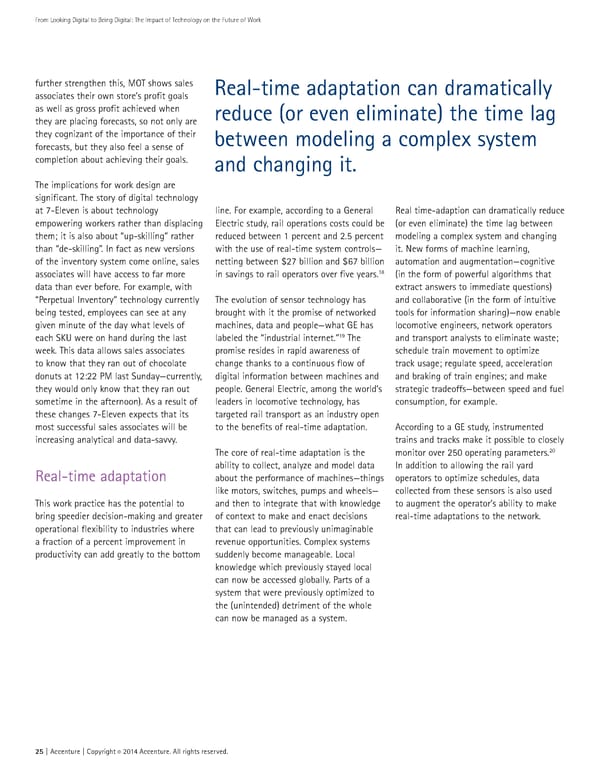From Looking Digital to Being Digital: The Impact of Technology on the Future of Work further strengthen this, MOT shows sales Real-time adaptation can dramatically associates their own store’s profit goals as well as gross profit achieved when reduce (or even eliminate) the time lag they are placing forecasts, so not only are they cognizant of the importance of their between modeling a complex system forecasts, but they also feel a sense of completion about achieving their goals. and changing it. The implications for work design are significant. The story of digital technology at 7-Eleven is about technology line. For example, according to a General Real time-adaption can dramatically reduce empowering workers rather than displacing Electric study, rail operations costs could be (or even eliminate) the time lag between them; it is also about “up-skilling” rather reduced between 1 percent and 2.5 percent modeling a complex system and changing than “de-skilling”. In fact as new versions with the use of real-time system controls— it. New forms of machine learning, of the inventory system come online, sales netting between $27 billion and $67 billion automation and augmentation—cognitive 18 associates will have access to far more in savings to rail operators over five years. (in the form of powerful algorithms that data than ever before. For example, with extract answers to immediate questions) “Perpetual Inventory” technology currently The evolution of sensor technology has and collaborative (in the form of intuitive being tested, employees can see at any brought with it the promise of networked tools for information sharing)—now enable given minute of the day what levels of machines, data and people—what GE has locomotive engineers, network operators 19 each SKU were on hand during the last labeled the “industrial internet.” The and transport analysts to eliminate waste; week. This data allows sales associates promise resides in rapid awareness of schedule train movement to optimize to know that they ran out of chocolate change thanks to a continuous flow of track usage; regulate speed, acceleration donuts at 12:22 PM last Sunday—currently, digital information between machines and and braking of train engines; and make they would only know that they ran out people. General Electric, among the world’s strategic tradeoffs—between speed and fuel sometime in the afternoon). As a result of leaders in locomotive technology, has consumption, for example. these changes 7-Eleven expects that its targeted rail transport as an industry open most successful sales associates will be to the benefits of real-time adaptation. According to a GE study, instrumented increasing analytical and data-savvy. trains and tracks make it possible to closely 20 The core of real-time adaptation is the monitor over 250 operating parameters. ability to collect, analyze and model data In addition to allowing the rail yard Real-time adaptation about the performance of machines—things operators to optimize schedules, data like motors, switches, pumps and wheels— collected from these sensors is also used This work practice has the potential to and then to integrate that with knowledge to augment the operator’s ability to make bring speedier decision-making and greater of context to make and enact decisions real-time adaptations to the network. operational flexibility to industries where that can lead to previously unimaginable a fraction of a percent improvement in revenue opportunities. Complex systems productivity can add greatly to the bottom suddenly become manageable. Local knowledge which previously stayed local can now be accessed globally. Parts of a system that were previously optimized to the (unintended) detriment of the whole can now be managed as a system. 25 | Accenture | Copyright 2014 Accenture. All rights reserved. ©
 From Looking Digital to Being Digital Page 23 Page 25
From Looking Digital to Being Digital Page 23 Page 25